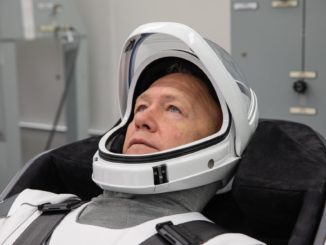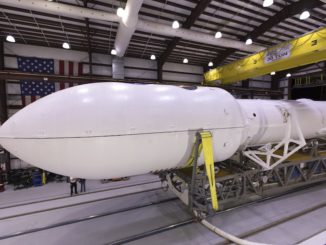EDITOR’S NOTE: The Demo-2 mission’s May 27 launch attempt was scrubbed due to poor weather. SpaceX plans another launch attempt at 3:22 p.m. EDT (1922 GMT) Saturday, May 30.
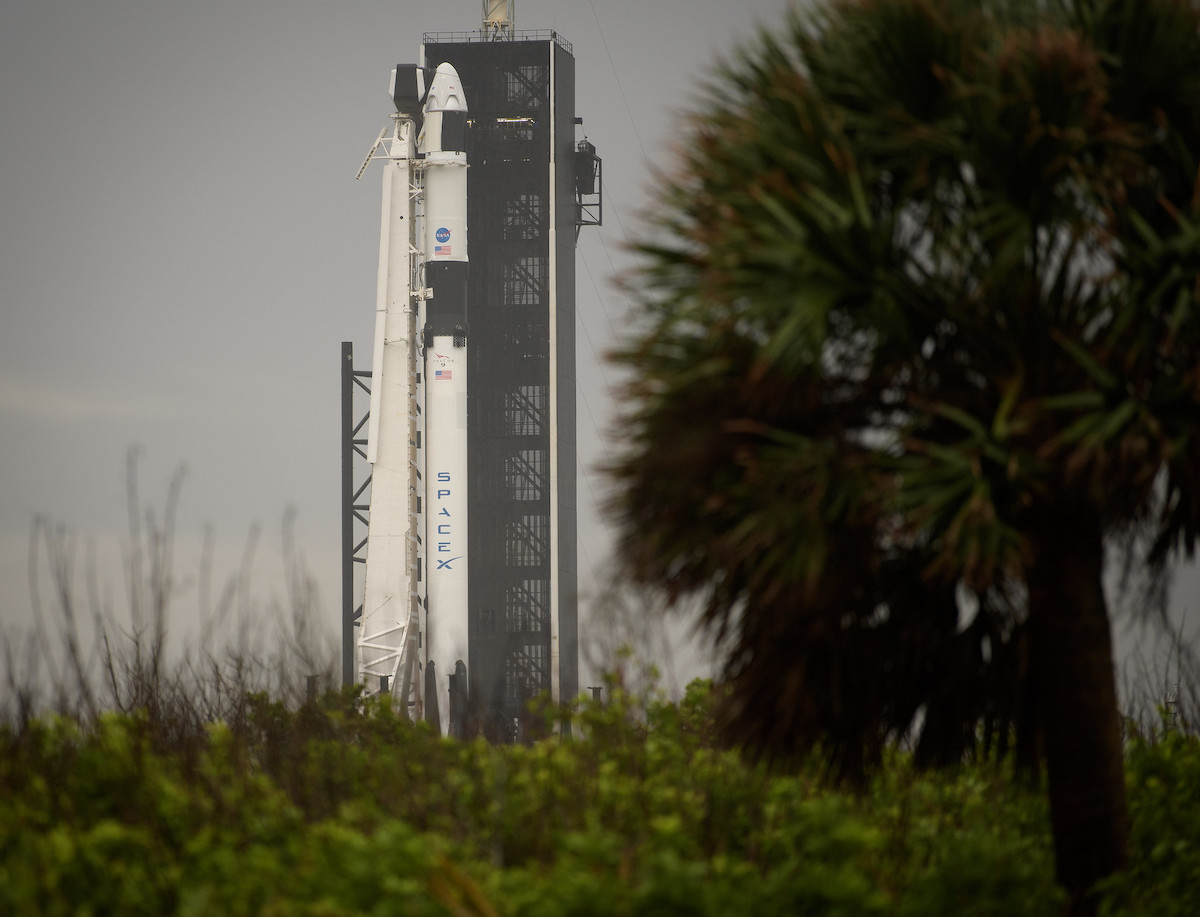
Mission managers will be closely monitoring the weather for the first launch of astronauts aboard SpaceX’s Crew Dragon spacecraft, not just around the Kennedy Space Center, but along a corridor stretching thousands of miles across the Atlantic Ocean in case the crew capsule has to escape from its Falcon 9 rocket during the climb into orbit.
The parameters to screen for acceptable weather downrange were added on top of the standard launch weather rules that track cloud, lightning and wind conditions at Cape Canaveral.
The official weather outlook for Wednesday’s launch opportunity — set for 4:33 p.m. EDT (2033 GMT) — calls for a 60 percent chance of favorable conditions for liftoff of the Falcon 9 rocket from the Kennedy Space Center with astronauts Doug Hurley and Bob Behnken on-board.
But those odds only take into account the weather forecast at the launch site. SpaceX and NASA officials will consider weather conditions downrange in the Atlantic Ocean during Wednesday’s countdown before making the final decision to launch.
“We have a really complicated way of weighting different locations, depending on how much risk they have in terms of an escape,” said Hans Koenigsmann, SpaceX’s vice president of build and flight reliability. “For the landing, there are also special parameters: winds, waves and wave direction.
“Some of these individually have to go ‘green’ and be a ‘go,’ and then on the entire launch corridor we have a common risk number that we use to basically make an assessment, and then get to a go/no go decision,” Koenigsmann said Monday.
The downrange weather assessment involves risk matrices and numerous factors. To illustrate the various criteria, Koenigsmann said a weather briefing Monday looking at the abort weather constraints consisted of 65 presentation slides.
“It took an hour, so it’s a lengthy process to get to the best result, getting the safest flight that we can possibly get with the current weather,” Koenigsmann said.
According to NASA’s list of launch commit criteria for the SpaceX crew launch, the flight will not proceed if downrange weather shows a high probability of violating limits at splashdown in the event of a Dragon launch escape maneuver.
Mission managers will monitor weather conditions at more than 50 locations along the launch ascent track, which heads northeast from the Kennedy Space Center along the East Coast of the United States and Canada. The corridor then extends across the North Atlantic Ocean toward Ireland.
“Probability of violation is calculated for each location including limit conditions for wind, waves, lightning, and precipitation,” NASA officials wrote in a launch weather criteria document for the crew mission.
“We’re looking at wave velocity and wave height, because we need to make sure that if the crew had to come down in a launch escape scenario that they would come down in a sea state that would keep them safe, and the rescue forces would be able to come and get them,” said Benji Reed, SpaceX’s director of crew mission management.
“I would expect there to be a very high chance of scrub due to weather,” Reed said in a press conference in early May. “Given the time of year, it wouldn’t surprise me at all.”
But officials won’t make that cal until launch day, once they plug real weather data into their risk models. There are also upper level wind constraints unique to the Falcon 9 rocket. The Falcon 9’s first stage booster will attempt to land on a drone ship in the Atlantic Ocean northeast of Cape Canaveral for eventual reuse, a maneuver that comes with its own weather criteria.
“There are buoys along the way, there’s global weather patterns, there are models,” Koenigsmann said. “And that’s how we basically integrate this whole risk along the way and come up with an assessment.
“There is also obviously an onshore component with wind that’s important to us in case we have a pad abort,” Koenigsmann said. “We also have a wave requirement for landing the booster, and a wind requirement for landing the booster. iI you take all of those up, it’s actually turning into a lot of weather science.”
SpaceX will provide a weather briefing to the Dragon astronauts around four hours before launch, before the crew puts on their SpaceX-made launch and entry flight suits.
“Usually, when we have a satellite to launch, then we go sometimes down to the wire, to the last minute,” Koenigsmann said. “In this case, we don’t want to do that because we would expose the crew to risk that would be unnecessary. So we’re going to weigh this like six hours before, four hours before, and … the final call comes at the end, at 45 minutes, as we’re going to arm the escape system.
“By that time, we’ll have come to a conclusion whether we’re go or no go.”
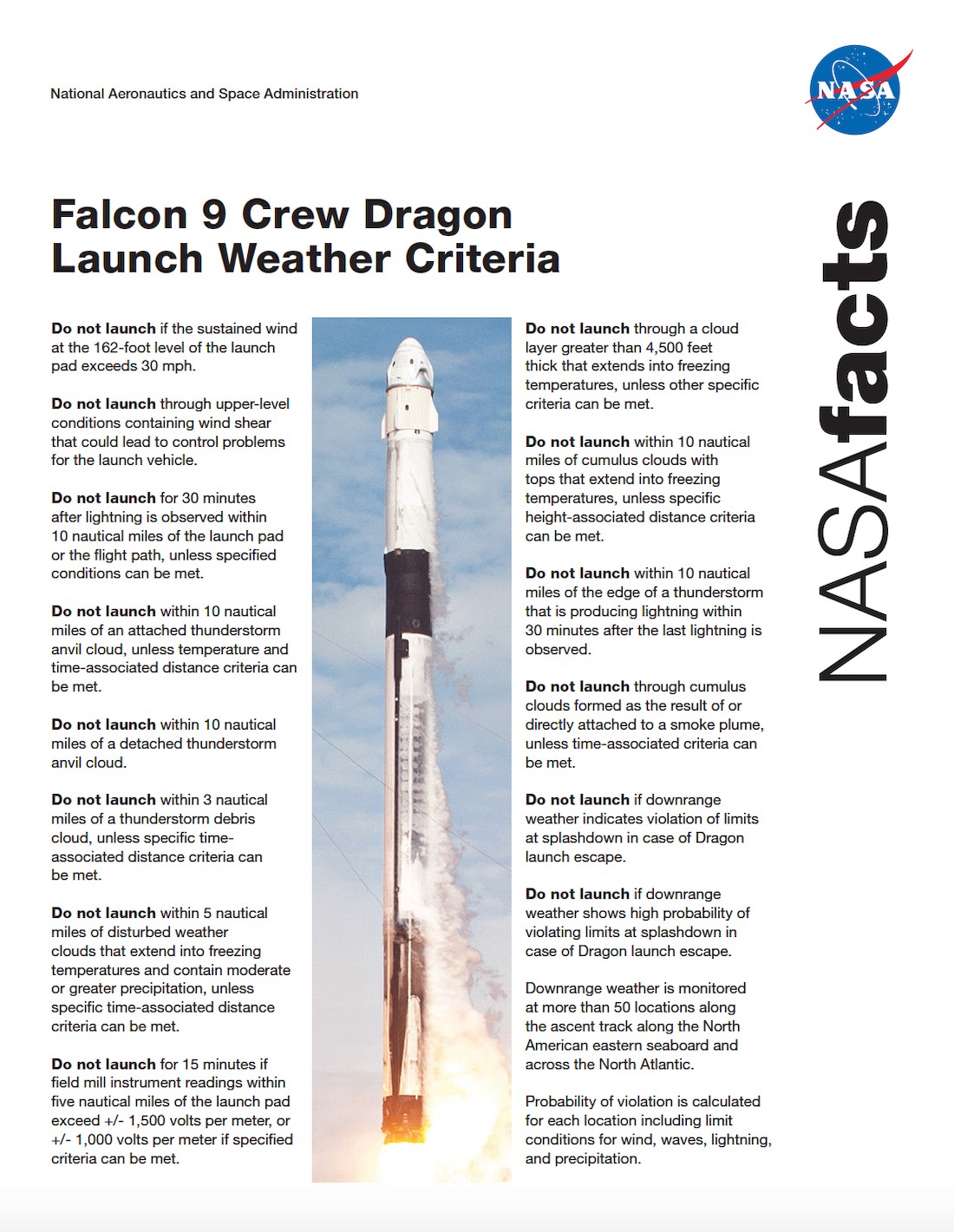
“If the weather’s good all the way, it’s an easy decision,” said Steve Payne, NASA’s former launch integration manager for the commercial crew program. “If the weather’s bad all the way, then that’s kind of an easy decision. It’s when you have some good and some bad, then you have to weigh what’s your likelihood of having an issue at any one of these places. So you weigh things like wave height, the temperature of the water, wind speed, darkness, storm conditions, lightning, things like that, because if you end up landing in those conditions you have to send somebody out there to get your crew. These folks jump into the water and they’re subject to being out there in all those conditions.
“So we do a weighing of risk, and it’s a calculated risk,” said Payne, who helped develop the crew rescue requirements before his retirement from NASA at the end of April. “It’s never going to be perfect. But if your possibilities of landing in that area are infinitesimally small, you’ll take that chance because it’s the only way you’ll ever fly.
“On launch day, for our first time, we’ll probably be conservative,” Payne said. “I expect we’ll have to have lots of things line up nicely to get off the ground. But it’s one of those things we’ve thought hard about it. We’ve come up with some criteria.”
If needed, the Crew Dragon spacecraft has eight SuperDraco engines that would propel the capsule off the top of its Falcon 9 launcher in the event of a problem during the climb into orbit.
It’s unlikely an escape maneuver would be required, but the abort system gives crews an extra layer of assurance. Space shuttle crews had fewer escape options, and no ability to abort in the event of a catastrophic launch failure.
During an in-flight escape test in January, the SuperDracos pushed an unpiloted Crew Dragon capsule off of a full-size Falcon 9 rocket during launch. The engines accelerated the spacecraft to a velocity of nearly 400 mph relative to the rocket’s speed, ensuring sufficient separation from the Falcon 9 to save the ship’s crew if astronauts had been on-board.
Launch abort systems have been used during emergencies on other rockets, most recently in October 2018, when a Russian Soyuz booster failed two minutes after liftoff. The Soyuz abort rockets fired to safely carry Russian cosmonaut Alexey Ovchinin and NASA flight engineer Nick Hague away from the Soyuz booster as it tumbled out of control.
Rescue teams assigned to Detachment 3, part of the 45th Space Wing at Patrick Air Force Base south of Cape Canaveral, will be on alert to deploy and retrieve the Dragon astronauts if there’s a launch abort in the first couple of minutes after liftoff.
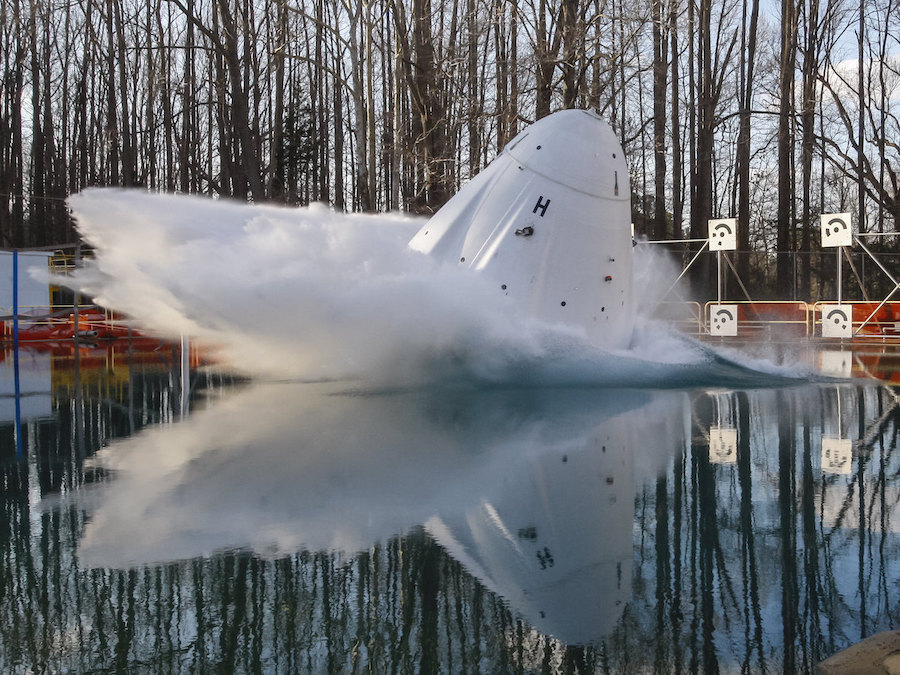
A major problem in the last 35 minutes before liftoff, when the Falcon 9 rocket is being loaded with super-chilled kerosene and liquid oxygen propellants, could also result in a pad abort that would booster the crew capsule off the launch vehicle to parachute into the Atlantic Ocean just off Florida’s coast.
The Detachment 3 teams from Patrick Air Force Base include an HC-130 transport and refueling plane, and two HH-60 Pave Hawk helicopters with search and rescue teams on-board, according to NASA officials.
The military pararescue specialists will parachute from the aircraft into the Atlantic with inflatable boats.
SpaceX is responsible for recovering the Crew Dragon spacecraft after a normal landing. At the end of a normal mission, the Crew Dragon splashes down at sea, with a primary zone in the Atlantic Ocean east of Florida and a backup zone in the Gulf of Mexico.
For a crewed mission, the search and rescue team at Patrick Air Force Base will have primary responsibility for retrieving the astronauts from the Crew Dragon spacecraft after a pad abort or launch emergency in the first few minutes of the flight, a scenario that would lead to a splashdown within about a 230-mile (370-kilometer) radius from Cape Canaveral.
NASA required its commercial crew transportation providers to design their crew capsules to avoid splashing down in the middle of the North Atlantic Ocean — where cold water temperatures and rough seas are common — in the event of an in-flight abort late in the ascent sequence.
If required, thrusters on the Crew Dragon or Starliner spacecraft would fire after an abort to ensure the capsule lands within about 300 miles of eastern Canada or Ireland, officials said.
“Once you detach from a failing rocket, you will either have enough propellant to slow down and land before you get there, or to boost you to the other side of that zone,” Payne said.
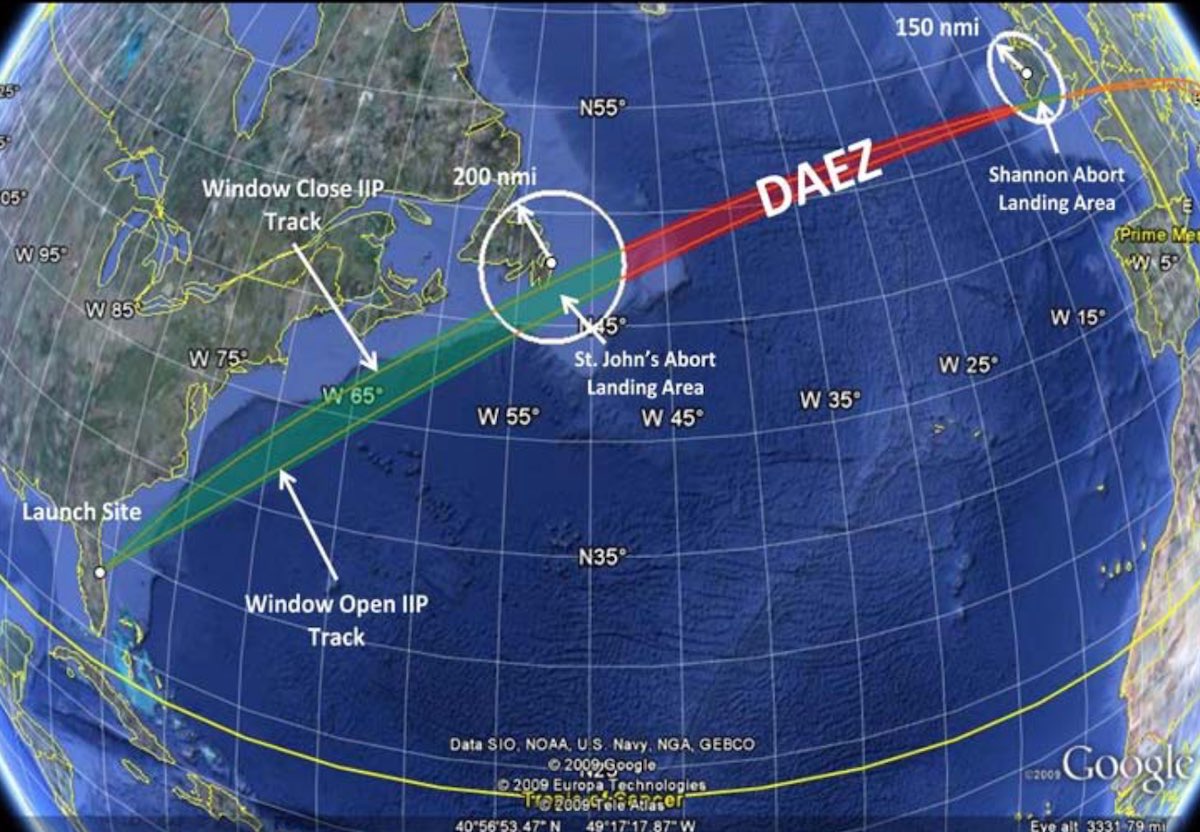
There are eight abort modes during a Crew Dragon launch, beginning with the pre-launch pad abort capability. During ascent, SpaceX divided the flight sequence into seven abort modes covering the Falcon 9’s first and second stage burns.
The Crew Dragon will reach orbit by the time the second stage engine shuts down at T+plus 8 minutes, 47 seconds.
For commercial crew launches, beginning with the Crew Dragon’s first piloted test flight this week, a C-17 cargo plane from Charleston Air Force Base in South Carolina will be on standby to respond for a sea rescue farther away from the launch site in Florida. A C-17 aircraft with a similar search and rescue team would deploy from Hickam Air Force Base, Hawaii, for an emergency landing in the Pacific Ocean or neighboring seas.
The Crew Dragon carries a radio beacon to help the military search and rescue team locate the spacecraft. The spacecraft also has flashing lights, and crews will carry handheld radios and personal locator beacons to communicate with search and rescue teams if the astronauts have to leave the spacecraft after splashdown.
The SpaceX crew capsule also has a raft on-board, plus a survival kit with medications, food and fresh water, signaling mirrors, blankets and other equipment, according to NASA.
Military rescue teams are also equipped with a larger life raft that can accommodate the search and rescue forces, along with the astronaut crews, and carries provisions for up to three days.
Payne said NASA and SpaceX have shared information about the Crew Dragon launch trajectory, along with instructions on how to open the capsule’s hatch and retrieve the crew members, with maritime rescue teams in Canada and Ireland.
Email the author.
Follow Stephen Clark on Twitter: @StephenClark1.

